Destination: Arizona
February 12 - 18, 2003
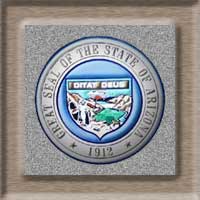
|
Destination: Arizona February 12 - 18, 2003 |
 |
Kathy and I had seen most of northern Arizona a year ago and we now planned to see the southern half of the state on this trip. We took the 97 minute flight from Sacramento to Phoenix, picked up our rental car and headed for our first destination - Casa Grande Ruins National Monument, about an hours drive south of Phoenix near the town of Coolidge.
Casa Grande Ruins National Monument contains the ruins of an ancient Hohokam farming village as well as the enigmatic Great House. The Great House is a four story structure whose function remains a mystery to archeologists. It may have served as a residence for important leaders or it may have been used as an astronomical lookout as holes in the walls admit sunlight on the equinox and solstices. Maybe it was the first Native American casino? Whatever it was, it is most impressive even in ruins.
|
In 1932, the park service built a huge metal cover to
protect the ruins. The park ranger there said that the cover is now a
registered historic structure as it is over 50 years old. Eventually, they will
keep building covers to preserve the covers so that in 1,000 years there will
be 10 covers and the original ruins will be gone. From Casa Grande, we drove to Gila Bend. On the way there we passed through Sonoran Desert National Monument. We found out that it is so new, there is not even a visitor's center there yet. |
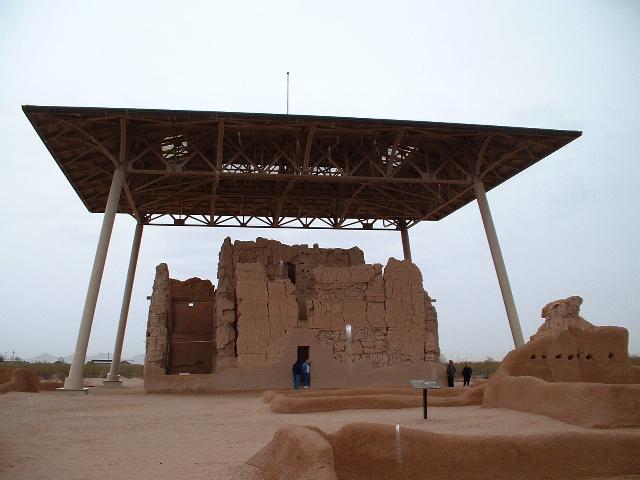 Casa Grande Ruins National Monument |
We arrived at Gila Bend in the early evening and checked into the Space Age Lodge complete with a flying saucer marquee and a space-themed mural in the lobby. Apparently, the original owner had NASA connections in the early 60's.
The next day, we headed south toward the US/Mexico border and saw Organ Pipe Cactus National Monument. Organ Pipe cactus look like...surprise...organ pipes and are common in Mexico and are only found in a small area north of the border. This area is also the most pristine area of the Sonoran Desert so that is why the National Monument was created.
We wanted to do some hiking there but were told that that morning, there was an "incident" at the border and the hiking trail was closed. We found out later that night while watching the news that the incident was pretty serious - a man driving in from Mexico refused a U.S. Customs inspector's request to get out of his vehicle because the inspector suspected the man was smuggling drugs. The inspector tried to pull the man out of his vehicle, a struggle ensued and the inspector shot and killed the man.
We were able to drive on one of the dirt roads in the monument and see some of the beautiful scenery. We got up pretty high into the mountains and saw an impressive natural bridge that was at first hidden in the clouds.
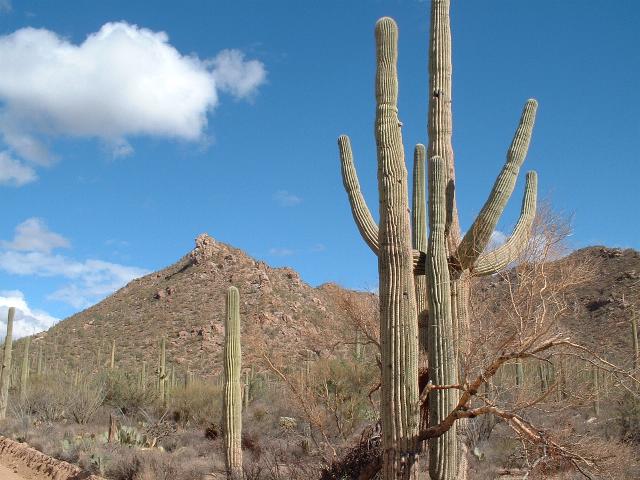 Saguaro National Park |
From Organ Pipe Cactus National Monument, we headed toward Tucson where we visited Saguaro National Park which is divided into an east and west section with Tucson in between. The park is named for the Saguaro cactus which is the Arizona state flower. This cactus can reach 50 feet in height and live for 200 years. Some have "arms" on them that are twisted in some pretty interesting shapes. The west section was more scenic and we did a short hike there up a hill that had rocks covered with ancient petroglyphs. |
We spent the night in Tucson and headed out the next day to Oracle, a town about 25 miles north of Tucson to see the Biosphere 2 Center. Biosphere 2 is the glass and steel complex built by a Texas billionaire. It was completed in 1991 and contains an ocean, a rain forest and a desert. It was designed for an experiment in which four men and four woman would be locked inside and survive on their own by growing their own food, etc., for two years. The whole huge structure was actually sealed so the plants inside had to provide all the oxygen. According to our guide, the eight original Biosphereians were beamed up to space by William Shantner who just happened to be the narrator of the film in the visitor's center.
We got to tour inside and outside the complex. One amazing engineering aspect of the complex is two giant "lungs" contained in two separate geodesic domes. These lungs are actually 16-ton steel discs surrounded by a huge airtight bladder. The purpose of these lungs is to relieve the pressure inside the complex - without them, the complex would actually explode from the pressure change due to the fact that it is airtight. The disks actually rise up and down just from the pressure change.
Another group tried to live in the Biosphere 2 complex but that experiment was cut shot because they had an air problem. After a few years of being vacant, Columbia University took over the complex and it is now being used for all types of ecological experiments such as determining the effects of global warming. They can change the temperature and make it rain inside.
Our next destination was Tumacacori National Historical Park about 50 miles south of Tucson. The park contains a Spanish mission that was completed in 1800 and abandoned in 1848 because of a series of Apache raids and a hard winter.
On the way back to Tucson, we stopped at another Spanish mission - San Xavier del Bac which was completed in 1797. While the Tumacacori mission is not in very good condition, this mission is very well preserved and quite beautiful.
We spent another night in Tucson. It was Valentine's Day so I wanted to treat Kathy to a nice romantic dinner. We decided on a restaurant but when we got there, we were told it would be a two and a half hour wait. At that point, we realized that Valentine's Day is probably one of the busiest days of the year for restaurants and each place we tried after that had a one to two hour wait. We kept lowering our standards and finally ended up in a coffee shop and got right in. Next year, it's back to flowers and chocolate!
|
The next day, we drove about 20 miles south of Tucson to Green River to see the Titan II Missile Museum. There were 54 Titan II missile complexes located near Tucson, Arizona, Little Rock, Arkansas and Wichita, Kansas. They were all dismantled between October 1981 and May 1987 after President Reagan made the decision to phase out the aging system. A veteran's group was able to save this one site as a museum. We took the tour of the site including the control room and silo which contains an actual Titan II Missile. |
 Titan II Missile Silo: "Don't touch that button!" |
The silo doors were half open with huge blocks that prevent the doors from fully opening. These door blocks can be seen from satellites in space so it can be determined that this missile isn't going anywhere.
The control room is located 35 feet underground and the docent went through the complete launch procedures. He explained how the orders to fire would come in and be verified, how the crew got the code to use and the fact that the crew did not know the location of the target. Kathy got to turn one of the two keys that launched the missile. Once the missile was launched, the crew had enough food and water for 30 days but there would probably be nothing left to come out for as these missiles were to be launched in retaliation. Of course, the whole concept of wiping out everyone on earth is insane but the tour was very fascinating.
Our next stop was supposed to be Kartchner Caverns State Park. I say supposed because when we got to the entrance, the sign said all tours were full for the day. This was a big disappointment because I have wanted to see this cave for several years since I first read about it. I have been to many of the famous caves but Kartchner is supposed to be one of the top three caves in the U.S. It turns out the tours were sold out for the whole month of February - we didn't realize it was so popular.
We ended up driving further south and visited Fort Huachuca. Fort Huachuca is still an active Army base. It was made a permanent fort in 1882 and it's 4th Calvary patrols chased Geronimo in 1886 until he surrendered. It also served as a staging ground for the 10th Calvary's 1916 march into Mexico as a spearhead of General John J. Pershing's punitive expedition. We saw the museum and several building dating to the 1890's which are still being used.
From Ft. Huachuca, we headed east to Willcox. On the way, we saw 21 billboards along Interstate 10 advertising "The Thing?". We had heard about "The Thing" and decided that if we found it, we would check it out.
"The Thing" is located in a museum in back of a combination gift shop/Dairy Queen/gas station. We each paid our dollar entrance fee and proceeded to follow the yellow footprints on the ground which led to the first building of the museum. This was the oddest museum we had ever seen. There were all kinds of bizarre items and everything was covered in about an inch of desert dust. There were old firearms, torture devices, and many items made out of branches or driftwood that were painted and made to look like some kind of strange animals.
We didn't see "The Thing" so we followed the yellow footprints to the next building. It contained more strange items including a 1937 Rolls Royce supposedly used by Adolf Hitler (I guess his Mercedes was in the shop at the time) but "The Thing" was still nowhere to be found. We followed the yellow footprints to yet a third building and eureka! Among more strange items in this building, we found "The Thing" and what a strange thing it is. You'll just have to go to Arizona and see it for yourself. If it is real, it is pretty incredible.
I think if you look up "tacky" in the dictionary, you will see a picture of this museum but it was still fun, different and only cost a buck. And we got away from this "tourist trap" with only purchasing a couple of ice cream cones from Dairy Queen.
 Chiricahua National Monument |
 Gray-Breasted Jay in Chiricahua |
After spending the night in Willcox, our next stop was Chiricahua National Monument. The monument is situated in the Chiricahua mountains which range in elevation from 5,180 to 7,825 feet. This area was once controlled by the Chiricahua Apaches under Cochise in the 1860's.
Among the monument's outstanding features are gigantic, erosion-sculptured monoliths of volcanic rock. These rocks are why Chiricahua is also called the "Wonderland of Rocks". We hiked 3.3 miles through the wonderland and got there early enough so that we had the trail all to ourselves for most of the hike. Some of the rocks are truly amazing, especially the large rocks that are balanced on pedestals.
From Chiricahua National Monument, we headed back east to Tombstone, the "town too tough to die". On the way there, I spotted something unusual in the sky toward the south. I noticed it wasn't moving and didn't look like any type of aircraft. We stopped the car and I looked at the object through the video camera zoom and binoculars and it really had an odd shape so I didn't think it was a blimp (blimps don't stay in one place either). I though this might be my first UFO sighting but a waitress in Tombstone explained to us that it actually is a surveillance blimp tethered over Fort Huachuca. It is used to catch drug smugglers and illegal aliens coming over the border. Oh well, it was a UFO until I had to ask the waitress.
In Tombstone, we saw the obligatory gunfight re-enactment in the OK Corral (and of course this was the one place the video camera decided not to work), and all the other historical /tourist places there including the Bird Cage Theatre, the Tombstone Epitaph newspaper office, the Crystal Palace Saloon, etc. etc.
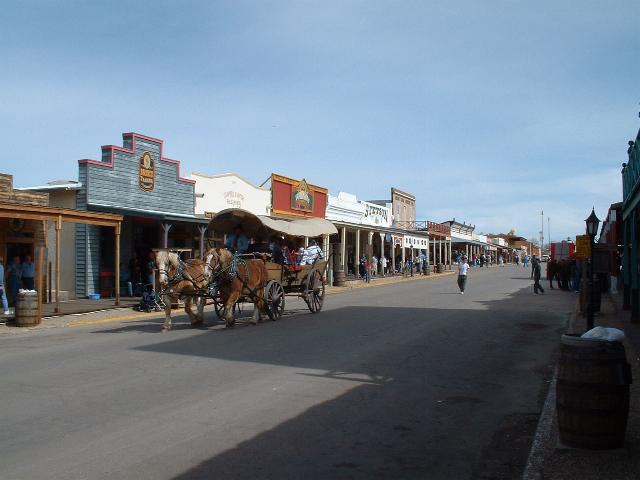 Allen Street, Tombstone |
I think my favorite place in Tombstone was the Boothill Cemetery. Besides the four cowboys killed at the OK Corral by the Earp brothers and Doc Holliday being buried there, one of the epitaphs that I read as a kid in Ripley's Believe it or Not can be seen there on one of the grave markers: "Here lies Lester Moore four slugs from a 44 no less no more". It seems like everyone buried there was either murdered, hanged or even lynched by mistake. |
From Tombstone it was a short drive south to Bisbee. We went there to take the Queen copper mine tour. We donned hard hats, lights and raincoats (must rain in the mines sometimes?) and rode what looked like a small train into the mine. Our guide worked in the mine for 30 years and for some reason couldn't stay away in retirement. It was a good tour and we made it out without causing a cave-in.
|
After spending the night in Casa Grande, we drove to Tonto National Monument. The big site to see there are the cliff dwellings. The lower cliff dwelling can be reached by a fairly steep hike up a mountain. The Salado people who built these dwellings nearly 700 years ago really had a room with a view. After one last picnic, we headed for Phoenix about 110 miles to the west. Our flight home didn't leave until around 7:00 p.m. so in Phoenix we visited the capitol museum, walked around the America West Arena and Bank One Ball Park, and had dinner at Majerle's Sports Grill. |
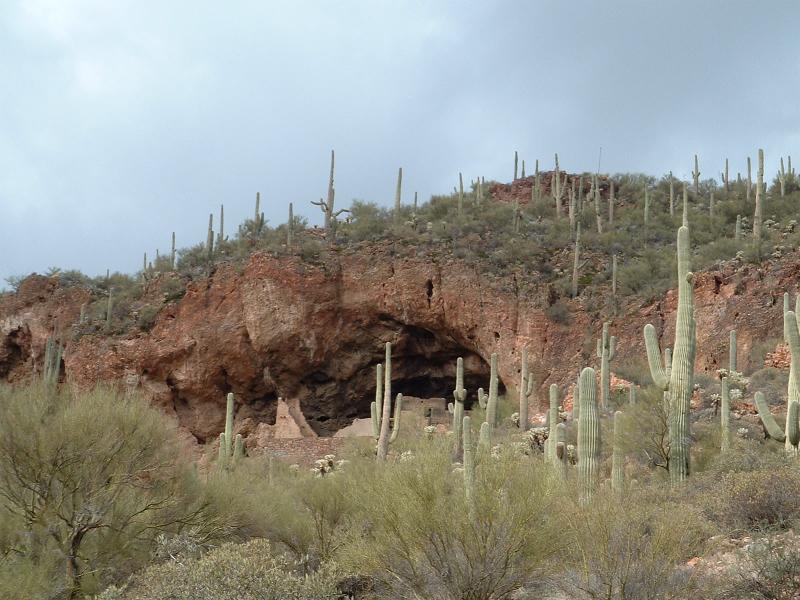 Tonto National Monument: Lower Cliff Dwelling |
We drove 1,522 miles on this trip. We had mostly rain the first four days and then it turned sunny and warm the last three days. The rain didn't stop us from doing or seeing what we wanted though and in fact, some of the cloud formations really added a nice backdrop to the beautiful desert scenery. Even though we missed seeing Kartchner Caverns, this was another great trip!